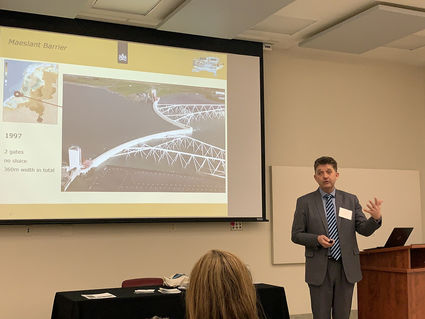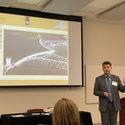County’s research offers Dutch treat, many questions
Last updated 3/3/2020 at Noon
Photo: Marc Walraven, senior storm surge barrier adviser for the Dutch infrastructure and water management agency, explains to Texas officials how the Netherlands protects its citizens with a multi-billion-dollar system of barriers and sea gates on Feb. 20 in Galveston.
Dave Rogers
For The Record
Never let it be said that Orange County leaders don’t know where to find people with answers to their problems.
And when it comes to water management, you go to the go-to guys on the subject, the Dutch.
Fortunately for the county’s travel budget, the Dutchman in charge of his country’s storm surge barriers was in Galveston Thursday, Feb. 20, and a half dozen Orange County leaders were on hand for Marc Walraven’s presentation arranged by the Texas General Land Office and the U.S. Army Corps of Engineers.
County Judge John Gothia, County Commissioners Johnny Trahan, Robert Viator and Kirk Roccaforte, Bridge City Councilwoman Terrie Gauthier and Don Carona, general manager of Orange County Drainage District, were among about 30 interested audience members at Galveston’s Rosenberg Library.
Walraven is Senior Storm Surge Barrier Advisor for Rijkswaterstaat, the Dutch national agency over infrastructure and water management. The country spends $3 billion a year to maintain its sea barriers.
The Corps of Engineers, GLO and their engineering, environmental and public outreach consultants are busy working out details for a Coastal Spine network of seawalls and sea gates to protect the Texas coastline and the cities above it from storms and rising sea level.
Handouts at Thursday’s meeting included Galveston-centric information with diagrams of “Proposed Galveston Ring Barrier” featuring some sea gates and barriers like the ones in the Netherlands.
The country also known as Holland, with a population of 17 million, lies northeast of England, directly facing the North Sea. Three of the biggest rivers in western Europe, the Rhine, the Meuse and the Scheldt, crisscross the country and drain into the Sea.
Half the land in the Netherlands is below sea level, Walraven said, with as much as 60 percent in the flood plain.
Sounds a bit like Orange County, but with a kicker.
The six huge storm surge barriers built at an expense of billions of dollars since a 1953 North Sea storm caused floods that killed 1,836 Dutch citizens and left another 100,000 homeless – “It was comparable to Katrina,” Walraven said – have succeeded in keeping high seas out of the country but don’t include any pumps to force out any water, such as the rain-event flooding from Tropical Storms Harvey and Imelda.
“I tell the Corps every time we meet with them, we’ve had one surge event [Hurricane Ike in 2008] but we’ve had four rain events, so the rain events are much more crucial to us than the surge events,” Trahan, Orange County’s Precinct 1 Commissioner, said. “I’d like protection from both of them if I can get it.
“And I don’t think there’s any reason this thing can’t be designed to protect us from both.”
Roccaforte, the Precinct 3 Commissioner, wished Southeast Texas had some Dutch-style storm protection.
“The whole thing was interesting,” he said. Asked if he could foresee something like the barrier system Walraven talked about at the head of the Sabine-Neches shipping channel, he nodded and said, “and Cow Bayou and Sabine, that would be interesting.
“We might get to see it in our lifetime, maybe.”
The poster boy for the Dutch barriers is the Maeslant Barrier, with two giant arms nearly 700 feet long that swing on ball bearings that are 10 meters (32 feet) across and connect in the middle of the channel to protect Rotterdam, Europe’s largest seaport.
“Their gates were built to hold water from one direction, but not two. If I owned those things, I would make sure I put in enough drainage apparatuses to make sure it drained well so I didn’t end up destroying my gates,” Trahan said.
ÂÂÂÂÂÂÂÂÂÂThe country’s famous windmills were installed several hundred years ago to pump water in and out of terraced fields used for farming tulips and the cows that produced milk for the cheeses, two products the Dutch are famous for. Mostly, wind power has been replaced by electric generators.
Walraven admitted that the focus was on the safety of the people after the flooding nearly 70 years ago. The country developed “The Delta Plan,” which he said was basically “just close off every waterway and estuary.” The motto after the catastrophic flooding was “Never again.”
However, in recent years, environmental concerns have arisen in the Netherlands. Protesters tried in vain to stop the opening of the Eastern Scheldt Barrier, which they feared would close the estuary it was built to protect. In fact, the 62 sluice gates in the famous movable barrier are normally left open for water and fish to flow in and out, Walraven said.
He did mention that the huge ball joints on the Maeslant Barrier had to be reengineered and replaced just five years after the colossal project was completed in 1997 because environmental rules changed and the grease used to lubricate the bearings was deemed toxic to the waterways.
“Did we choose safety over fisheries? Yes,” Walraven said. “We had to do something because it’s the safety of our nation we’re worried about. We didn’t have environmental worries in the 1950s, but now we’re learning about it.”
The Orange contingent left impressed by the presentation but unsure if it was something the Corps of Engineers project architects might incorporate in Orange County.
“I found how those built those dams interesting, Robert Viator, Precinct 4 Commissioner, said. “To be honest, I never thought of the Netherlands and their flood issues. They had problems. They should be underwater.”-

















Reader Comments(0)